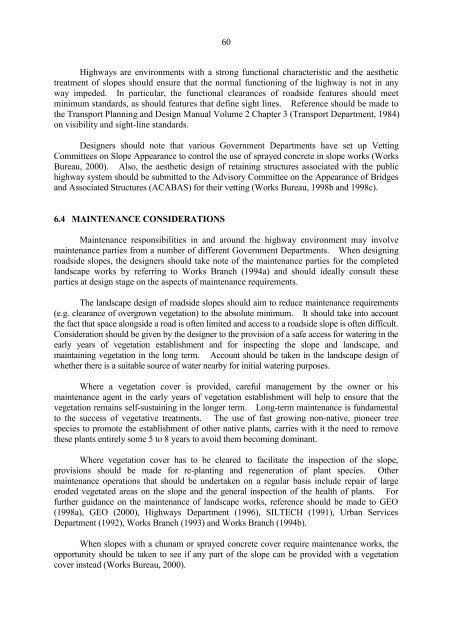Highway Slope Manual
Highway Slope Manual
Highway Slope Manual
You also want an ePaper? Increase the reach of your titles
YUMPU automatically turns print PDFs into web optimized ePapers that Google loves.
60<br />
ighways are environments with a strong functional characteristic and the aesthetic<br />
treatment of slopes should ensure that the normal functioning of the highway is not in any<br />
way impeded. In particular, the functional clearances of roadside features should meet<br />
minimum standards, as should features that define sight lines. eference should be made to<br />
the Transport Planning and Design anual olume 2 Chapter 3 (Transport Department, 198.)<br />
on visibility and sight-line standards.<br />
Designers should note that various Government Departments have set up etting<br />
Committees on <strong>Slope</strong> Appearance to control the use of sprayed concrete in slope works (Works<br />
Bureau, 2000). Also, the aesthetic design of retaining structures associated with the public<br />
highway system should be submitted to the Advisory Committee on the Appearance of Bridges<br />
and Associated Structures (ACABAS) for their vetting (Works Bureau, 1998b and 1998c).<br />
6.4 AINTENANCE CONSIDERATIONS<br />
aintenance responsibilities in and around the highway environment may involve<br />
maintenance parties from a number of different Government Departments. When designing<br />
roadside slopes, the designers should take note of the maintenance parties for the completed<br />
landscape works by referring to Works Branch (199.a) and should ideally consult these<br />
parties at design stage on the aspects of maintenance requirements.<br />
The landscape design of roadside slopes should aim to reduce maintenance requirements<br />
(e.g. clearance of overgrown vegetation) to the absolute minimum. It should take into account<br />
the fact that space alongside a road is often limited and access to a roadside slope is often difficult.<br />
Consideration should be given by the designer to the provision of a safe access for watering in the<br />
early years of vegetation establishment and for inspecting the slope and landscape, and<br />
maintaining vegetation in the long term. Account should be taken in the landscape design of<br />
whether there is a suitable source of water nearby for initial watering purposes.<br />
Where a vegetation cover is provided, careful management by the owner or his<br />
maintenance agent in the early years of vegetation establishment will help to ensure that the<br />
vegetation remains self-sustaining in the longer term. ong-term maintenance is fundamental<br />
to the success of vegetative treatments. The use of fast growing non-native, pioneer tree<br />
species to promote the establishment of other native plants, carries with it the need to remove<br />
these plants entirely some 5 to 8 years to avoid them becoming dominant.<br />
Where vegetation cover has to be cleared to facilitate the inspection of the slope,<br />
provisions should be made for re-planting and regeneration of plant species. Other<br />
maintenance operations that should be undertaken on a regular basis include repair of large<br />
eroded vegetated areas on the slope and the general inspection of the health of plants. For<br />
further guidance on the maintenance of landscape works, reference should be made to GEO<br />
(1998a), GEO (2000), ighways Department (1996), SITEC (1991), rban Services<br />
Department (1992), Works Branch (1993) and Works Branch (199.b).<br />
When slopes with a chunam or sprayed concrete cover require maintenance works, the<br />
opportunity should be taken to see if any part of the slope can be provided with a vegetation<br />
cover instead (Works Bureau, 2000).

















